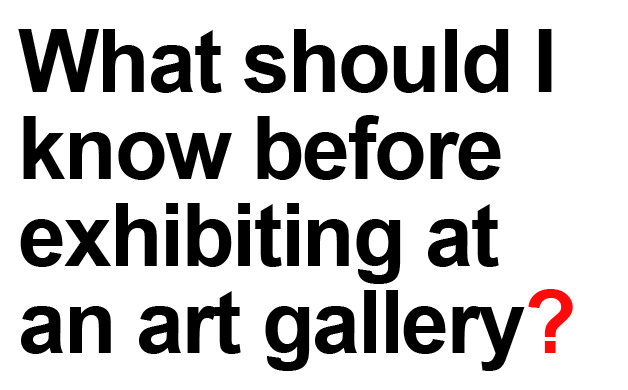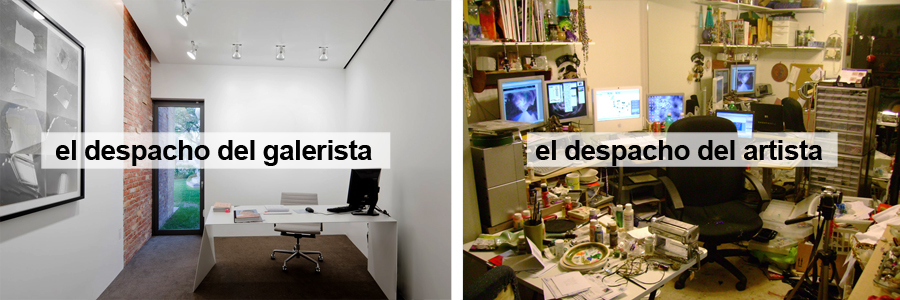

In any professional relationship between an artist and an art gallery manager there should be a written contract whereby the essential conditions prior to that relationship must be set out.
Below, we lay out some of the points, broadly speaking, that should be taken into account before the artist signs a contract with a gallery. This, in no way, should be considered a substitute for an actual contract, but a document that can be used to analyze the level of commitment between each of the parties. The Right Practice Code in Visual Arts and a sample of this contract (Spanish version) can be read and downloaded here: MODELO DE CONTRATO CON GALERÍA PARA EXPOSICIÓN PUNTUAL. A contract must consider the consequences that a breach of the contract implies. Therefore, it would be pointless to state that an artist´s work must be paid in full within a stated period if a penalty for failing to meet a deadline is not established.
What components must be taken into account? :
- Exhibition dates:
- Opening date:
- Number of works to be exhibited:
- The artist will provide a list of the works that take part in the exhibition: YES/NO
- The gallery will keep the works on deposit after the exhibition ends: YES/NO
- Specify the number of works and length of time kept on deposit:
- The art gallery will hand in a dispatch note detailing the works above mentioned: YES/NO
- The gallery will have an insurance policy to cover the artist´s works: YES/NO
- The gallery will meet transport/delivery expenses: YES/NO
- The gallery will meet the transport expenses to return the works to the artist: YES/NO
- The gallery will cover production costs (canvases, frames, etc) : YES/NO
- Ordinary and extraordinary expenses will also be covered by the gallery:
- Assembly devices: YES/NO
- Costs to fit the works into the gallery space: YES/NO
- Accommodation: YES/NO
- One way trip: YES/NO
- Return trip: YES/NO
- Bus, subway, taxi, etc. rides: YES/NO
- Daily expense allowance: YES/NO
- Others (specify) : YES/NO
- A price list agreed upon by the artist is included: YES/NO
- The sale percentage the gallery gets is_____%
- In case of special discounts the artist has the last say: YES/NO
- Specify the works that may be subject to discounts and the percentage applied:
- The works that have been sold shall be paid in full within a period of:
- In this exhibition the artist is considered: COLLABORATOR / GALLERY ARTIST / SINGLE EXHIBITION
- If there is an exclusive relationship between the parties it will be considered: INTERNATIONAL / NATIONAL / REGIONAL
- The artist will have control of the way his/her works are going to be disseminated: YES/NO
- The artist commits him/herself to comply with the exhibition dates previously agreed upon with the artist: YES/NO
- The gallery could ultimately cancel the exhibition if the works fail to meet the manager´s expectations or else the artist does not fulfill the terms of the contract: YES/NO
Oral contracts are void and null and give rise to many disputes, as lots of clauses should have been discussed beforehand. A signed contract protects both parties and formalizes a professional agreement that considers all aspects and situations that all commercial relationships entail. The artist should be fully aware of the paramount importance to learn to use the art traders tools to his own advantage and become familiar with them so as to keep the myriad of problems he has nowadays at bay, partly due to the inexistence of documents that without which he cannot defend him/herself in case of discrepancies or misinterpretations of verbal pacts. Therefore if the artist does not face the situation individually and collectively and is not aware of the importance of knowing his/her rights as well as the means to protect them, he will always be the weaker party among the rest of the agents that make up the cultural market.

the art gallery manager´s office vs. the artist´s “office”
A contract allows both parties to negotiate the terms, and offers them an opportunity to foresee and anticipate problems that may be encountered during the professional relationship, as well as how to work them out.
OBJECT OF THE CONTRACT:
- Formalization and minimum content of a contract
- Obligations to which both parties commit themselves
- A system whereby the artist gets paid
- Copyrights (how they can be implemented)
- Causes to terminate a contract
- Establish when a contract becomes null and void
- General conditions of a contract
DOWNLOAD SAMPLE OF A CONTRACT WITH A GALLERY FOR A SINGLE EXHIBITION (Spanish sample): MODELO DE CONTRATO CON GALERÍA PARA EXPOSICIÓN PUNTUAL
If you need any help, you are doubtful or are a member of AVVAC (Artistes Visuals de València, Alacant i Castelló), our lawyer, Alex Devís (LA SEU law office) is at your disposal, to whom you may consult(via email) anything connected with contracts, copyrights, etc., free of charge.
Gracias desde AVVAC a Live Trinity College por el servicio de traducción (Live Trinity College Facebook)